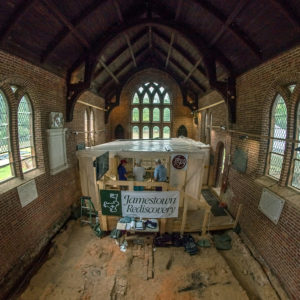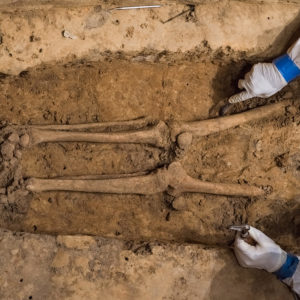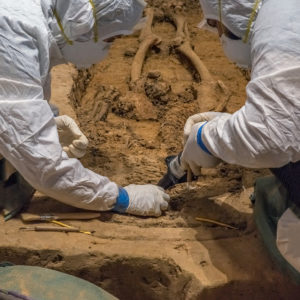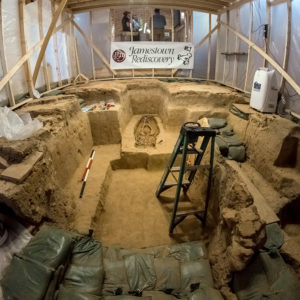This month’s update continues with details about the excavation and analysis of the “Grave in the Aisle,” which began the end of July. Jamestown Rediscovery speculates that the skeletal remains uncovered belong to Sir George Yeardley, the governor who presided over the first meeting of the General Assembly in July 1619, and who was also one of the first slave owners in English America. Tradition has always suggested that Yeardley was buried in the 1617 church and that the “Knight’s tombstone” originally marked his grave.
Rediscovery archaeologists excavated the aisle burial from July 21st-23rd. They began by working west to east, and quickly identified a stain and multiple nails that formed the outline of a hexagonal-shaped coffin. As coffin nails were discovered, they were mapped in situ using surveying equipment because in 2013, this technique helped determine the styles and construction of coffins excavated in the 1608 church chancel. Mortar and brick fragments found in the grave fill provided evidence of a brick aisle above. If DNA sequencing proves that these are Yeardley’s remains, the mortar and brick indicates that the 1617 church had a brick aisle when he was buried in November 1627.
Using the high-frequency GPR data obtained with the assistance of GSSI, archaeologists exposed human remains and quickly recognized that the GPR data was accurate in terms of body position. The feet were in the west, while the head lay in the east: a position that is the reverse of a traditional Christian burial. GPR images showed that the individual’s left tibia had rolled outward during decomposition, which also proved to be accurate upon excavation. As archaeologists approached the western end of the grave, elevations indicated that there was insufficient space for a cranium. While the GPR data was unclear about the whether the cranium survived, it did show something in that area.
The recovery of the individual’s cranium was critical. In addition to providing information about sex, origin, and facial characteristics, the skull contains two bones in which ancient DNA best survives: the petrous temporal. The petrous temporal bones, one behind each ear, are among the densest bones in the human body. The Rediscovery team had hoped to find an intact cranium, scan it, and deliver it to an FBI lab at Quantico, where scientists would extract the petrous temporal bone for DNA sequencing for possible identification.
Recognizing that the cranium was likely disturbed by a later 17th century grave, the Rediscovery team reviewed the records of earlier excavations conducted over the past year. Burial disturbances are common in churches and churchyards in the 17th century and later because of limited space. As predicted, a disarticulated cranium and mandible with missing teeth had been found in a later burial located directly to the east. But because sterile excavation procedures were not implemented when the disarticulated cranium was discovered, Rediscovery discussed the necessity of finding another DNA source: teeth. The team recognized that it was imperative to prove that the disarticulated cranium belonged to the grave in the aisle.
Excavations of the grave Sunday morning confirmed that the cranium was indeed missing. A circular soil stain of loam showed where the cranium originally laid, and also what the GPR data indicated. Thus, the disarticulated cranium likely belongs to the individual in the aisle! Fortunately, archaeologists also uncovered 10 disarticulated teeth during the excavation, another possible source for DNA analysis if the petrous temporal sample proves to be unsuccessful.
Rediscovery is collaborating with Dr. Turi King of the University of Leicester. King is the renowned geneticist who led the research on the identification of King Richard III in 2013. Her willingness to share lessons learned from that project has helped the Rediscovery team prepare for the excavation of the grave in the aisle.
Once the ancient DNA is extracted and analyzed, geneticists, genealogists, and archaeologists hope to find a living Yeardley relative for comparative DNA analysis. King said that the individual must be related to Yeardley in one of two ways: she or he must be related either through an all-female-line, in which there are no men in the genealogy chain leading back to Yeardley’s mother, or through an all-male-line with no women in the genealogical chain back to Yeardley. The last of Yeardley’s male descendants, who would have inherited this unique DNA, were his grandsons. The fourth generation were all female. This means that scientists will likely make a connection through Yeardley’s mother or father, grandfather, or another male ancestor.
Forensic analysis conducted by the Smithsonian Institute’s Skeletal Biology Program is also critical in identifying the burial. Rediscovery archaeologists were joined once again by Dr. Douglas Owsley and Kari Bruwelheide, whose initial examination determined that the remains belong to a European male approximately 40 years of age. Owsley concluded that the previously discovered disarticulated cranium also corresponded with this age. In addition to the age correlation, the newly discovered teeth fit in the mandible where teeth were missing. As well, the first cervical vertebra found in the grave fit the cranium fragments perfectly, leading Owsley and his team to conclude that these fragments matched the individual.
The forensic analysis and DNA analysis should be completed by early 2019 and the analysis of tests involving microbiome and soils will return in a few months.
related images
- The Jamestown Rediscovery team constructed a climate-controlled “clean room” over the archaeological dig within the Memorial Church in order to resist contamination
- Archaeologists in Tyvek suits excavate and map the burial. This burial dates between 1617 and 1644. Left to right: Bob Chartrand, Mary Anna Hartley, Dave Givens, and Michael Lavin
- Within the coffin outline, excavations of the lower half of the skeletal remains revealed the individual to be well-preserved
- Gloved, masked, and in Tyvek suits, archaeologists Mary Anna Hartley and Bob Chartrand work on the disturbed eastern end of the burial associated with the 1617-1644 church. Multiple churches and later burials on site impacted the earliest individuals. This person’s cranium and mandible were discovered in the fill of a previously-excavated impacting burial.
- Overview looking west within the climate-controlled “clean room.” Archaeologists believe the burial to be Sir George Yeardley, sitting Governor of the first General Assembly in 1619. Ancient DNA analysis of the bones will be compared to living Yeardley relatives for confirmation.










